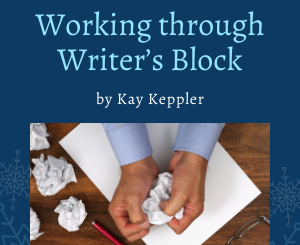7 Tips for Paragraph Revision: Getting the Details Right by Kay Keppler
 Let’s welcome back monthly columnist, editor, and novelist, Kay Keppler, as she shares with us “7 Tips for Paragraph Revision: Getting the Details Right!” Enjoy!
Let’s welcome back monthly columnist, editor, and novelist, Kay Keppler, as she shares with us “7 Tips for Paragraph Revision: Getting the Details Right!” Enjoy!
***
Let’s say that you’ve written the first draft of your novel, and maybe you’ve even checked to see that all your turning points, your scenes and sequels, are where they’re supposed to be. The action rises the way you want it to, your ending ties up loose story threads. Your book is complete, but it’s rough.
The Devil’s in the Details
Now it’s time to revise closely. You want to pay attention not just to your sections or chapters, but your paragraphs. You want them to capture your readers and hold them to the page. Alicia Rasley, a writer and teacher, has pointed out some things you want to look out for. (Editor’s note: Alicia Rasley has some posts here on Writer’s Fun Zone blog.)
- Uniform topic. Pretend your mother points to a spot in your book and asks, “What is this paragraph about?” Could you tell her in a single phrase or, at the most, a single sentence? (Let’s say, it’s “when Harry met Sally.”) If any words, ideas, sentences, or thoughts are not about Harry meeting Sally—if Sally wonders where she’s going to live, or Harry wonders where he can get a cold beer—that material should be placed elsewhere.
- Appropriate length. What idea are you conveying in this paragraph? If that one big idea needs two pages to explain, you probably need more than one paragraph to do it. If you’re writing an action/reaction, for example, maybe you need two paragraphs. (Let’s say, one paragraph for when Harry musters up the courage to approach Sally from across the room, and a second paragraph to describe how Sally reacts as if he’s a mugger.) Separate paragraphs do more to highlight individual moments, and readers’ eyes get exhausted from passages that are too long.
- First sentence. The first sentence of the paragraph sets up the rest. Does it introduce what you want to say effectively? Is it too long, complicated, short, or bland? Make it work hard for you—make sure it introduces a problem, advances the character arc, or sets the stage for action.
- Character development. Often it’s a good idea to start the paragraph from the viewpoint of your POV character (so rather than “Harry hustled across the room,” you’d say, “Harry was terrified as he hustled across the room” or “Sally eyed the stranger nervously as he hustled across the room”). And related to “Appropriate length,” how many named characters are in your paragraph? Don’t name the guy watching Harry hustle across the room unless he becomes important later.
- Event sequence. Readers find it easier to follow a chronology, so usually you’d want to describe events in the paragraph the way they happen for the character. Think about cause before effect, action before reaction, and event before response. (Of course, if you have a reason to change the sequence, see how you can do that effectively.) Sometimes when a paragraph feels ragged, it’s because the sequence of events is just a little bit off (“Sally saw a strange man stalking her and shrieked in fear,” rather than “Sally shrieked in fear when she saw a strange man stalking her.”)
- Word choice. Do your word choices all help to deliver the tone you want and amplify the mood? Check for repetition, including useless padding such as “just” and “actually,” or “favorite” words that get overused.
- Dialogue and action. Punctuate and tag any dialogue correctly. Each speaker gets a new paragraph, no matter how short the dialogue, so Harry gets a new paragraph when he says, “You’re the most interesting woman in the room!” And then Sally gets a second paragraph when she replies, “Why, thank you!” Usually, if a paragraph has both dialogue and action, they proceed in sequence. (“Sally looked around to see if the madman was addressing her. ‘Why, thank you!’ she said.” Conversely, “ ‘Why, thank you!’ Sally said, sticking out her hand to shake.”)
It’s a Beat
Paragraphs are little units of fiction, a beat of action, or character development. Each paragraph should have an arc, however tiny. When you’re revising, think about where you want your readers to go—and make sure that every word, phrase, and sentence in that beat takes them there.
***
ABOUT THE AUTHOR
Kay Keppler is an author Zero Gravity Outcasts, Betting on Hope, Gargoyle: Three Enchanting Romance Novellas, and editor of fiction and nonfiction –Angel’s Kiss and Outsource It!
is an author Zero Gravity Outcasts, Betting on Hope, Gargoyle: Three Enchanting Romance Novellas, and editor of fiction and nonfiction –Angel’s Kiss and Outsource It!
She lives in northern California. Contact her here at Writer’s Fun Zone in the comments below, or at kaykeppler@yahoo.com to ask questions, suggest topics, or if you prefer, complain.






